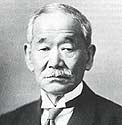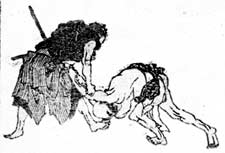
Someone sent me this link. As usual, there is an excerpt below. If you'd like to read the whole thing, click here.
The Old Samurai Art Of Fighting Without Weapons
Part 1 - Origins

By Jigaro Kano
Translated by Rev. T. Lindsay, April 18, 1888
Submitted by Stan Hart
Editor’s Note: This is the first part of an article originally written by Jigaro Kano, the founder of modern Judo (Jiudo). Part 1 investigates the origin of Jiujutsu (Jujutsu). There is also a glossary provided by Stan Hart, who translated the Japanese Kanji (characters) used in the original text. Part 2 discusses various schools and relates some stories about old Jiujtsu masters. The romanization of Japanese words that appear in this article are based upon the spellings used in England at the time the article was written.
In feudal times in Japan, there were various military arts and exercises by which the Samurai classes were trained and fitted for their special forms of warfare.
Among these was the art of Jiujutsu (1), from which the present Jiudo (2) has sprung up. The word Jiujutsu may be translated freely as the art of gaining victory by yielding or pliancy. Originally, the name seems to have been applied to what may best be described as the art of fighting without weapons, although in some cases short weapons were used against opponents fighting with long weapons.
 Although it seems to resemble wrestling, yet it differs materially from wrestling as practiced in England, its main principle being not to match strength against strength, but to gain victory by yielding to strength.
Although it seems to resemble wrestling, yet it differs materially from wrestling as practiced in England, its main principle being not to match strength against strength, but to gain victory by yielding to strength.
Since the abolition of the feudal system the art has for some time been out of use, but at the present time it has become very popular in Japan, though with some important modifications, as a system of athletics, and its value as a method for physical training has been recognized by the establishment of several schools of Jiujutsu and Jiudo in the capital.
3 comments:
Here's a related passage:
"When Jigoro Kano, the founder of judo, was quite old and close to death, the story goes, he called his students around him and told them he wanted to be buried in his white belt.
"What a touching story; how humble of the world's highest-ranking judoist in his last days to ask for the emblem of the beginner!
"But Kano's request, I eventually realized, was less humility than realism. At the moment of death, the ultimate transformation, we are all white belts. And if death makes beginners of us, so does life -- again and again. In the master's secret mirror, even at the moment of highest renown and accomplishment, there is an image of the newest student in class, eager for knowledge, willing to play the fool."
-- excerpted from Mastery, by George Leonard
Great story!
This is a nice story, but there's no evidence it happened, and the details of Kano's death do not line up with the story in any way. Prof Kano died on a ship traveling back to Japan. He did not have students with him. For more please see: https://www.reddit.com/r/judo/comments/c33gx4/til_kano_jigoro_the_father_of_judo_asked_to_be/erpn5m6
Post a Comment